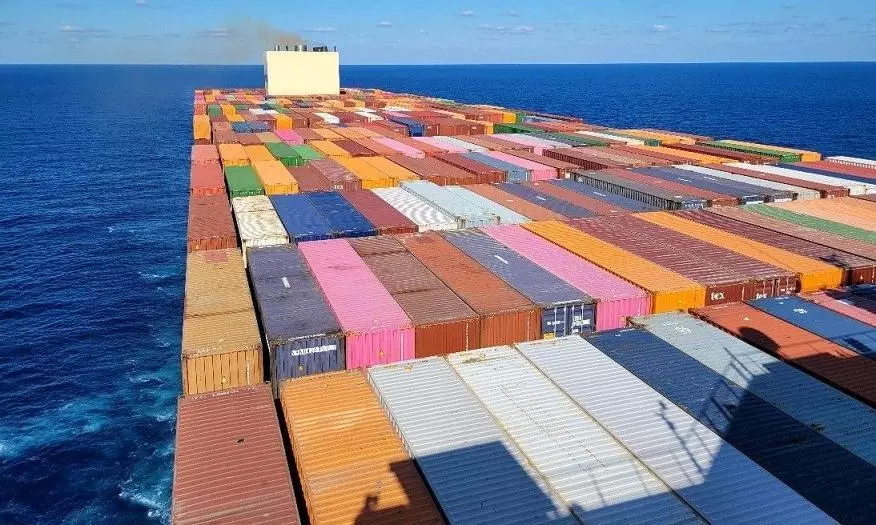2025 to be another challenging year for container shipping: Xeneta
"The lights are flashing red on the geo-political dashboard and it would be foolish to ignore them."

2025 is likely to be another challenging year in ocean container shipping, according to the Ocean Outlook report from Xeneta.
"If 2024 has been a year framed by conflict in the Red Sea, then expect more of the same because there is no sign of a political resolution that would allow a large-scale return of container ships to the region. This only heightens the danger for container shipping because there is little slack in the system to deal with another supply chain shock."
The Xeneta Ocean Outlook 2025 makes clear the impact diversions around Africa have on TEU-mile demand and available capacity in the market. New deliveries of ships and slowing TEU-volume growth will ease some of this burden but not enough to mitigate another major incident.
"Could we see a military escalation in the Taiwan Strait? Will regime change in Bangladesh cause further unrest? Will the situation in the Middle East deteriorate to impact shipping in the Persian Gulf? The lights are flashing red on the geo-political dashboard and it would be foolish to ignore them."
Xeneta's global average spot rate has softened since peaking in July as the long term market begins to rise. "The narrowing of the long-short market will be of great significance ahead of negotiations for new long term contracts in 2025. Shippers will be hoping the markets narrow further while carriers are doing their utmost to keep the spot market elevated."
Factors to watch in 2025
Demand is likely to grow by three percent in 2025 while total demand growth for 2024 is expected to be 4-5 percent and break through 180 million TEU, the update added.
"Massive demand growth from China to Mexico is expected to continue, and overall inflation to stay above the two percent threshold targeted by the European Central Bank and the Federal Reserve."
China to Mexico trade has been in the spotlight in 2024 with TEU-demand growth increasing 22.1 percent year-to-date compared with 2023. This follows the full year-on-year growth of 34.6 percent in 2023. "One of the key reasons is found in the cooling relations between China and the U.S. and Mexico being seen as a backdoor to avoid import tariffs. Looking ahead to 2025, demand is expected to increase further on this trade. Another one to watch is China to the Middle East where volumes are 52 percent up from 2021."
Peter Sand, Chief Analyst, Xeneta says: “Macro-economic developments set the overall direction for container shipping demand but it does not tell the whole story and shippers need to understand market nuances at a regional and port-to-port level. The upcoming U.S. Presidential elections will have a major influence on 2025 because the potential for new tariffs on Chinese imports could see shippers revisit their manufacturing and supply chain setups – and perhaps see a further acceleration in imports to Mexico.
“2024 was very much driven by frontloading of cargoes in addition to longer sailing distances. Any change in this approach next year represents a downward risk to demand – unless 2025 turns out to be even more dramatic.”
Major changes in alliances in 2025 will bring risk and opportunity, and the best carrier network will vary tremendously from trade to trade, the update added. "OCEAN Alliance (COSCO, CMA CGM and Evergreen) has most capacity and service loops in 2025, Gemini (Maersk and Hapag) may be the go-to alliance to avoid Singapore congestion and carriers may stop calling at some ports in 2025."
Shifting alliances will have a big impact at port level, Xeneta says in its report. "If you are shipping cargo from the Far East to Antwerp, then MSC is likely to be your preferred supplier with four weekly calls in 2025. This compares to one call a week with Premier Alliance (ONE, HMM and Yang Ming) and none from Gemini. A key point for shippers is to not assume your existing carriers will continue to call at the same ports in 2025."
Sand adds: "Shippers must understand what the new alliances are offering on the trades they utilise – and it comes down to far more than price. It is a balance between cost, reliability and transit time while also being aware the carrier you currently use may not be the best one going forward. Keep your options open, do not be afraid to challenge carriers and seek assurances they can deliver what they are promising, particularly around service reliability."
2024 has been a bruising year for shippers and they will hope 2025 brings some relief - but it is important to be realistic and prepare for further disruption, says the report.
First published on logupdateafrica



